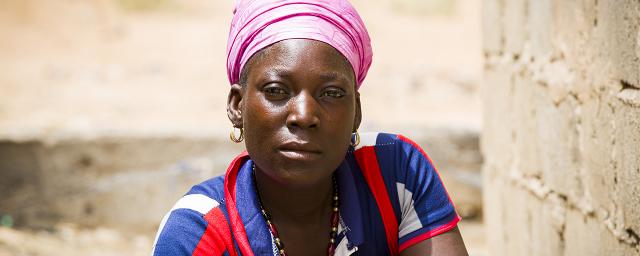
Zoré Fatimata in front of her house, in Burkina Faso. “Our eating habits have really changed because of the conflict, it is difficult to afford a decent meal. You have to ration and eat slowly, you eat in the morning and you have to search again.” In Burkina Faso, hunger levels rose by 213% since last year. Photo: Cissé Amadou/Oxfam
Since the Covid-19 pandemic began, vulnerable communities around the world have been sending a clear, urgent and repeated message: “Hunger may kill us before coronavirus”. Today, deaths from hunger are outpacing the virus.
Unabated conflict, economic disruptions fuelled by the pandemic, and the escalating climate crisis have deepened poverty and pushed millions more people into extreme levels of food insecurity, some to the brink of starvation.
There is no place or excuse for famine in the 21st century. If we stop conflict and climate crisis, if we support smaller farmers, if we fund lifesaving food programmes, we can end hunger today.
Catastrophic hunger spiralling
In our deeply unequal world, millions of people are living in, and dying from food deprivation every year. Last year, Oxfam warned that the “hunger virus” could prove more deadly than Covid-19. What we saw as a global health crisis has quickly spiralled into an inflamed hunger crisis, leaving millions on the brink of starvation.
20 million more people have been pushed to extreme levels of hunger this year, reaching a total of 155 million people.
The number of people living in famine-like conditions has increased sixfold since the pandemic to more than 520,000.
11 people are likely dying every minute from acute hunger, now outpacing COVID-19 fatalities.
The 3 lethal Cs accelerating hunger
Three lethal Cs have fuelled hunger and malnutrition in the world: conflict, Covid-19 economic shocks, and the climate crisis. Together, they have ravaged communities in the world’s hunger hotspots and established strongholds in new epicentres of hunger. Conflict remained the biggest driver of hunger around the globe for three consecutive years, including during the pandemic.
Faced with the unprecedented global pandemic of Covid-19, the UN called for a global ceasefire in March 2020. However, conflict has gone largely unabated continuing to be the primary cause of hunger for almost 100 million people across 23 countries. Afghanistan, Ethiopia, South Sudan, Syria, and Yemen – some of the world’s worst hunger hotspots – are all torn by conflict. Women and girls are hit hardest, often eating last and eat least. They face extraordinary dangers to get food, and yet, too often have to risk getting assaulted in order to feed their family.
More than a year and a half since the coronavirus pandemic was declared, the economic decline caused by lockdowns and closures of borders, businesses, and markets, has pushed tens of millions more people into hunger especially the most disadvantaged. Mass unemployment and severely disrupted food production have led to a 40% surge in global food prices – the highest rise in over a decade. More than 40 million people experienced extreme levels hunger primarily due to economic shocks largely caused by the pandemic. This is a near 70 percent increase over the previous year.
The climate crisis was the third primary factor pushing nearly 16 million people in 15 countries to crisis levels of hunger. Nearly 400 weather related disasters, including record-breaking storms and flooding, continued to intensify for millions across Central America, Southeast Asia, and the Horn of Africa. Yearly, climate disasters have more than tripled since 1980, with currently one extreme weather event recorded per week. Despite this, governments have delayed action to tackle the climate crisis to focus instead on the pandemic.
The greatest rise of inequality
The pandemic has also laid bare the greatest rise of inequality since records began. The estimated number of people living in extreme poverty is projected to reach 745 million by the end of 2021, an increase of 100 million since the pandemic started.
The most marginalized people including women, displaced people and informal workers have been hit hardest. Employment loss cost women around the world at least $800 billion in lost income in 2020. An additional 47 million more women worldwide are expected to fall into extreme poverty in 2021.
Meanwhile, the rich continued to get richer. The wealth of the 10 richest people – nine of whom are men – increased by $413 billion last year, enough to cover the entire UN humanitarian appeal for 2021 more than 11 times over.
Extreme hunger hotspots
Among countries and regions where the food crisis has worsened because of the pandemic, some are particularly concerning: Yemen, the Central African Republic, Afghanistan, Venezuela, the West African Sahel, Ethiopia, Sudan, South Sudan, Syria. Hunger has also intensified in emerging hunger hotspots like Brazil, India and South Africa, which also saw some of the sharpest rises in COVID-19 infections.
Ending hunger is possible
To end the hunger crisis, governments must first end conflict and allow aid agencies like Oxfam to reach those most in need, to help save lives now. To end hunger permanently, they must also rebuild a fairer and more sustainable global economy as they recover from the pandemic. They must tackle these key drivers of hunger and eradicate the underlying inequalities that widen the gap between rich and poor people.
They must focus their resources on providing social protection rather than on arms that perpetuate conflict and hunger. Saving just a day and a half’s worth of our global military spending – the equivalent of $8 billion– would be enough to fund the entire UN emergency food security appeal.
Help us save lives
Since the pandemic began, Oxfam has reached nearly 15 million of the world’s most vulnerable people with food, cash assistance and clean water, as well as with projects to support farmers. We work together with more than 694 partners across 68 countries.
Please support our work and help us do more
